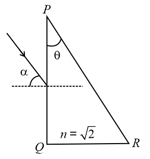EASY
Earn 100
The rainbow which forms when a light ray undergoes two total internal reflections inside a raindrop, is termed as:
(a)Primary rainbow
(b)Secondary rainbow
(c)Both (A) and (B)
(d)Can't say
50% studentsanswered this correctly
Important Questions on Ray Optics
MEDIUM
EASY
EASY
EASY
EASY
EASY
EASY
EASY

EASY
EASY
MEDIUM
HARD
MEDIUM
EASY
EASY
MEDIUM
HARD


